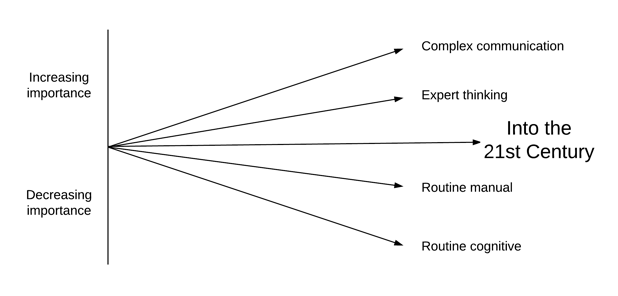Since the turn of the century, a seemingly never-ending series of advocates have told whoever will listen about the changing nature of work in the coming decades. Graphs such as this one I adapted from Levy and Murname (2005) seems to convey the typical message:

In general, these advocates predict employers will value different skills than previously.
I cannot disagree that new skills are necessary. I see the work done by people around me (including that in my adult children’s generation, and that in my generation who are into our third decade in the workforce), and I see it requiring different skills than were needed by my parents and their parents. I do think many advocated have missed one important change, however.
Technology is certainly embedded (deeply) in our work. We use computers to interact and to access and process and create information. What I observe that appears missing on much of the literature about “the future of work,” is the important role of humans who are skilled at navigating the space between technology and human affairs.
Consider these examples:
- A space planner in grocery stores who considers disparate information (some of it explicit, much of it implicit) to decide what products are sold in supermarkets and how much inventory of each product is kept. This individual uses sales information, demographics of store locations, industry trends, and conversations with local managers to plan what goes where on the shelves.
- The manufacturing professional who designs products and models them on computer screens before building the products and determining their quality. They then understand the technical and human parts of the manufacturing system to ensure the processes become more efficient and produce items that meet customer’s needs.
- The teacher who makes use of sophisticated graphing tools to allow students to play with graphs to see how they vary depending on the coefficients, constants, and exponents. Those teachers then help students translate the graphs into situations and measurements rather than spending time learning the rules and algorithms of graphing the equations.
Daniel Pink (2005) and others have reminded us the future of work is in the “things” humans can do, but computers cannot. Advocates for coding remind us that the future of work is in the ability to control the IT in our lives. I maintain the future of work lies in the ability to leverage IT to accomplish to tasks relevant to human needs.
References
Levy, F., & Murnane, R. J. (2005). The new division of labor: how computers are creating the next job market. New York: Russell Sage Foundation.
Pink, D. (2005). A whole new mind: Why right-brainers will rule the future. New York: Riverhead Books.